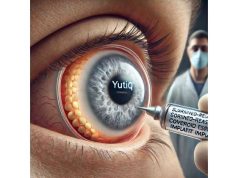
Cystoid macular edema (CME) is a leading cause of vision loss, characterized by fluid-filled cystic spaces in the macula—the central part of the retina responsible for sharp vision. This condition can occur after eye surgery, inflammation, diabetes, retinal vein occlusion, or other underlying diseases. If left untreated, CME can lead to permanent damage and substantial visual impairment. In this in-depth guide, we’ll explore CME’s causes, risk factors, gold-standard therapies, advanced surgical and technological interventions, and future directions for care—all to help you or your loved ones navigate the journey to clearer sight.
Table of Contents
- CME Basics: Pathophysiology, Prevalence, and Risk Insights
- Standard Therapies and Medical Management
- Procedural and Surgical Approaches
- Cutting-Edge Advancements and New Technologies
- Clinical Research and the Future of CME Care
- Frequently Asked Questions
CME Basics: Pathophysiology, Prevalence, and Risk Insights
Cystoid macular edema is defined by the accumulation of extracellular fluid in the macula, forming multiple cyst-like spaces within the retinal layers. This swelling disrupts central vision and can make daily activities challenging. Understanding how CME develops and who is at risk helps set the stage for effective prevention and management.
How Does CME Develop?
- The retina contains blood vessels that, when inflamed or damaged, can leak fluid into the macular region.
- This leakage leads to the characteristic “cystoid” appearance seen on OCT (optical coherence tomography), a high-resolution imaging test used for diagnosis.
Common Causes
- Post-Surgical CME: Particularly following cataract surgery (Irvine-Gass syndrome), but also after retinal or glaucoma procedures.
- Diabetic Retinopathy: Chronic high blood sugar damages retinal blood vessels.
- Retinal Vein Occlusion: Blockage of retinal veins leads to increased pressure and leakage.
- Uveitis: Inflammatory eye diseases disrupt the blood-retinal barrier.
- Medication-Induced: Certain prostaglandin analogs used for glaucoma can trigger CME.
Prevalence and Risk Factors
- CME affects approximately 1–2% of people after cataract surgery, with higher risk in those with diabetes or prior uveitis.
- Diabetic macular edema, a subtype of CME, is a leading cause of blindness in working-age adults worldwide.
- Other risks: prior eye trauma, vascular disease, genetic predisposition, and specific medications.
Key Symptoms
- Blurred or distorted central vision
- Washed-out or faded colors
- Difficulty reading or recognizing faces
- Wavy lines (metamorphopsia)
Diagnosis
- Clinical exam and retinal imaging (OCT and fluorescein angiography) are essential.
- Early diagnosis is crucial—untreated CME can lead to irreversible retinal damage.
Practical Advice:
If you’ve recently had eye surgery, have diabetes, or notice changes in central vision, schedule a prompt evaluation with your eye specialist.
Standard Therapies and Medical Management
Effective CME management depends on targeting both the underlying cause and the retinal swelling itself. Non-surgical treatments are often first-line and may resolve mild to moderate cases.
Primary Medical Treatments
- Nonsteroidal Anti-Inflammatory Drugs (NSAIDs) Eye Drops
- Widely used after cataract surgery; reduce inflammation and fluid leakage.
- Common agents: nepafenac, ketorolac, bromfenac.
- Dosage: Typically 1–2 drops daily for several weeks to months.
- Topical Corticosteroid Drops
- More potent anti-inflammatory effects; often prescribed with NSAIDs.
- Commonly used drops: prednisolone acetate, difluprednate, loteprednol.
- Risk: Prolonged use can raise eye pressure or increase cataract risk.
- Oral Carbonic Anhydrase Inhibitors
- Acetazolamide or methazolamide may be used for refractory CME, particularly when drops are insufficient.
- Intravitreal Medications
- Steroid Injections or Implants: Triamcinolone, dexamethasone, and fluocinolone slow-release implants are injected directly into the eye for severe or chronic CME.
- Anti-VEGF Injections: Aflibercept, ranibizumab, or bevacizumab target vascular endothelial growth factor to reduce swelling, especially for diabetic or vein occlusion-related CME.
- Systemic Medications
- In some uveitic cases, oral or IV steroids and immunosuppressants may be required.
Supportive Measures
- Blood sugar control (for diabetes)
- Blood pressure management
- Avoiding triggers (e.g., certain glaucoma medications)
- Regular monitoring with OCT imaging
Long-Tail Keywords Used Here:
- best eye drops for cystoid macular edema
- intravitreal injections for CME
- non-surgical treatment for macular swelling
Practical Advice:
Take your prescribed drops exactly as directed, even if your vision improves quickly. Consistent use is key to maximizing results.
Procedural and Surgical Approaches
When CME is resistant to medication, or in more severe cases, interventional procedures and surgery may offer additional hope for restoring vision.
Key Interventional Procedures
- Intravitreal Injection Therapy
- As described above, anti-VEGF and steroid agents are delivered directly to the retina in a sterile office setting.
- Injections are often repeated monthly or as determined by imaging and vision changes.
- Sustained-Release Implants
- Dexamethasone (Ozurdex) and fluocinolone (Iluvien) implants provide long-lasting medication release, reducing the frequency of injections.
- Especially useful for chronic or recurrent CME.
- Laser Therapy
- Focal/Grid Laser Photocoagulation: Used primarily in diabetic macular edema, this precise, low-intensity laser seals leaking blood vessels.
- Laser may not be effective for all types of CME and is less common than injections.
- Pars Plana Vitrectomy
- Surgical removal of the vitreous gel (and any inflammatory debris) can be helpful in severe, non-resolving CME, especially when caused by vitreomacular traction or persistent inflammation.
- May be combined with internal limiting membrane peeling for recalcitrant cases.
- Epiretinal Membrane Removal
- For CME caused by scar tissue formation (epiretinal membrane), microsurgical peeling may be indicated.
Risks and Recovery
- Risks include infection, retinal detachment, cataract, or increased eye pressure.
- Recovery varies; vision often improves gradually over weeks to months.
Long-Tail Keywords Used Here:
- surgical treatment for cystoid macular edema
- vitrectomy for macular swelling
- dexamethasone implant for CME
Practical Advice:
Arrange for someone to drive you home after procedures and attend all follow-up appointments—early intervention with complications ensures the best possible outcomes.
Cutting-Edge Advancements and New Technologies
CME management is evolving rapidly, with innovative solutions offering new hope to patients who previously had limited options.
Emerging Medical and Technological Innovations
- Next-Generation Intravitreal Therapies
- Longer-acting steroids, anti-VEGF, and dual-action drugs (anti-VEGF + steroid) are in development, aiming for fewer injections and more sustained control.
- Port delivery systems—tiny, refillable devices surgically implanted at the eye wall—offer steady medication release.
- Gene Therapy and Biologics
- Early trials are testing gene therapies targeting VEGF and inflammatory pathways, especially in diabetic or inherited CME.
- Biologics designed to suppress immune-related edema are being studied for uveitis-associated CME.
- Smart Imaging and AI Diagnostics
- Artificial intelligence tools now help detect subtle CME changes on OCT scans, guiding treatment frequency and adjustment for each patient.
- Home-based OCT devices, currently in trial, may soon allow patients to monitor CME from home.
- Minimally Invasive Surgical Devices
- Advances in microincisional vitrectomy have made surgery faster, safer, and more comfortable with rapid recovery.
- Novel Drug Delivery Methods
- Topical nano-formulated drops and subconjunctival sustained-release injections are being explored for more effective, less invasive treatment.
Long-Tail Keywords Used Here:
- new treatments for cystoid macular edema
- AI for CME diagnosis
- gene therapy for macular swelling
Practical Advice:
If your CME is not responding to standard care, ask your retina specialist about clinical trials or access to investigational therapies.
Clinical Research and the Future of CME Care
Clinical trials and research are accelerating the pace of CME breakthroughs—offering patients better, longer-lasting results with less burden.
Current and Upcoming Trials
- Ultra-Long-Acting Drug Implants
- Studies are evaluating drugs that can control CME for 6–12 months after a single injection or implant.
- Gene Editing for Chronic Macular Edema
- Early CRISPR and RNA-based therapies seek to correct underlying genetic or inflammatory causes.
- Personalized Medicine and Biomarker-Guided Therapy
- Researchers are identifying genetic, protein, or imaging biomarkers to customize therapy for each patient’s unique needs.
- Combination Therapies
- Dual and triple-agent regimens are being explored to target multiple pathways of fluid leakage and inflammation.
- Telehealth and Remote Monitoring
- Integrating AI and home imaging for more proactive, continuous care—especially vital for patients living far from specialty centers.
What’s on the Horizon?
- Reduced need for frequent injections or surgery
- Restoration of near-normal vision in more patients
- Earlier diagnosis and prevention, especially in high-risk groups
Long-Tail Keywords Used Here:
- clinical trials for CME
- new macular edema treatments
- future of retinal disease management
Practical Advice:
Stay engaged with your retina clinic and consider trial participation if you have persistent or difficult-to-treat CME. Being part of research can offer early access to the most advanced therapies.
Frequently Asked Questions
What is cystoid macular edema and what causes it?
Cystoid macular edema is swelling of the macula due to fluid buildup in cyst-like spaces. Common causes include eye surgery, diabetes, retinal vein occlusion, and eye inflammation.
What are the best treatments for cystoid macular edema?
The best treatments include anti-inflammatory eye drops, steroid or anti-VEGF injections, and addressing any underlying disease. In resistant cases, laser therapy or surgery may be needed.
How long does it take for CME to resolve?
Mild cases may improve within weeks to months with treatment, but chronic CME can persist and require ongoing therapy. Prompt management improves the chance of full recovery.
Is cystoid macular edema permanent?
CME can often be controlled or reversed with treatment, but long-standing or severe cases may cause permanent vision loss if not addressed early.
Are there new treatments or research for CME?
Yes, new long-acting drugs, gene therapies, AI-guided monitoring, and novel delivery systems are currently in clinical trials and offer hope for better long-term outcomes.
Can CME return after successful treatment?
Yes, CME can recur, especially if the underlying condition persists. Ongoing monitoring and regular follow-up are essential for timely retreatment.
What should I avoid if I have CME?
Avoid missing medication doses, skipping follow-ups, or self-treating without your doctor’s advice. Good blood sugar and blood pressure control also help prevent recurrence.
Disclaimer:
This article is for educational purposes only and is not a substitute for professional medical advice. For any vision changes or concerns about cystoid macular edema, promptly consult a retina specialist or ophthalmologist. Early diagnosis and individualized care are essential for the best outcomes.
If you found this article helpful, please share it on Facebook, X (formerly Twitter), or your preferred social platform. Your support empowers us to keep creating in-depth, evidence-based resources. Stay connected and follow us for more updates—thank you!










